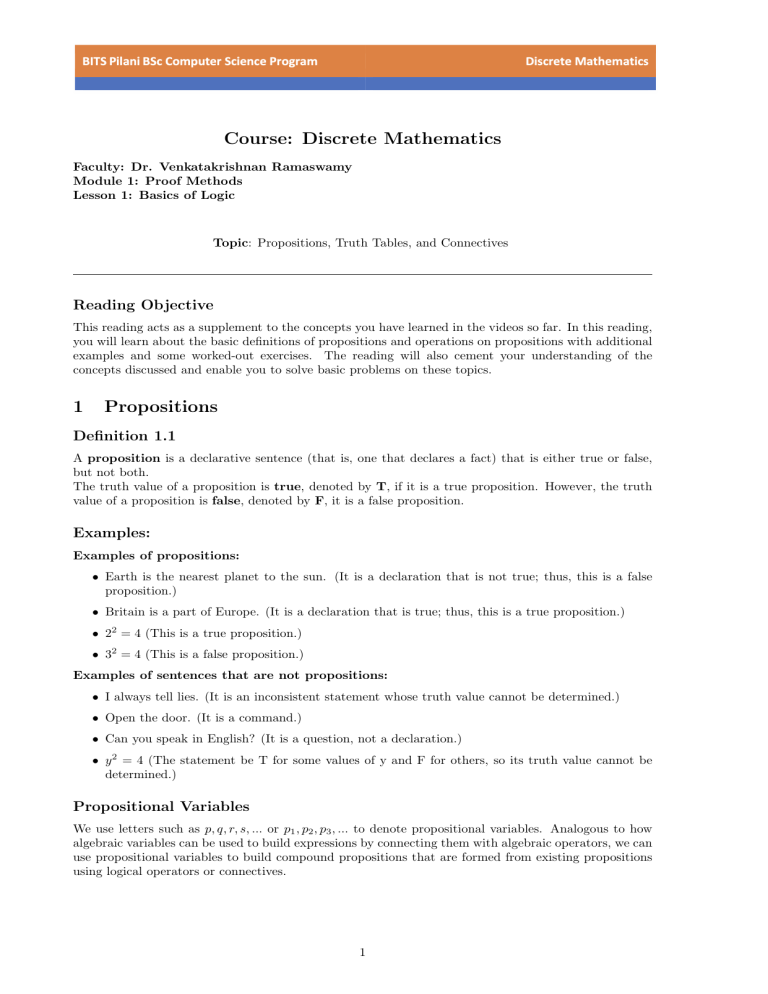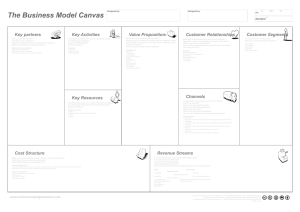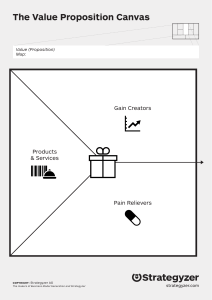
Course: Discrete Mathematics Faculty: Dr. Venkatakrishnan Ramaswamy Module 1: Proof Methods Lesson 1: Basics of Logic Topic: Propositions, Truth Tables, and Connectives Reading Objective This reading acts as a supplement to the concepts you have learned in the videos so far. In this reading, you will learn about the basic definitions of propositions and operations on propositions with additional examples and some worked-out exercises. The reading will also cement your understanding of the concepts discussed and enable you to solve basic problems on these topics. 1 Propositions Definition 1.1 A proposition is a declarative sentence (that is, one that declares a fact) that is either true or false, but not both. The truth value of a proposition is true, denoted by T, if it is a true proposition. However, the truth value of a proposition is false, denoted by F, it is a false proposition. Examples: Examples of propositions: • Earth is the nearest planet to the sun. (It is a declaration that is not true; thus, this is a false proposition.) • Britain is a part of Europe. (It is a declaration that is true; thus, this is a true proposition.) • 22 = 4 (This is a true proposition.) • 32 = 4 (This is a false proposition.) Examples of sentences that are not propositions: • I always tell lies. (It is an inconsistent statement whose truth value cannot be determined.) • Open the door. (It is a command.) • Can you speak in English? (It is a question, not a declaration.) • y 2 = 4 (The statement be T for some values of y and F for others, so its truth value cannot be determined.) Propositional Variables We use letters such as p, q, r, s, ... or p1 , p2 , p3 , ... to denote propositional variables. Analogous to how algebraic variables can be used to build expressions by connecting them with algebraic operators, we can use propositional variables to build compound propositions that are formed from existing propositions using logical operators or connectives. 1 Atomic Propositions Atomic propositions are propositions that can not be further divided into different propositions. Example of Atomic Proposition: p: India is a country. Compound Propositions Compound propositions are propositions that are formed by combining one or more atomic propositions using connectives.They are represented using letters such as P, Q, R, S, .... Example of Compound Proposition: Q: India is a country, and it is a part of Asia. 2 Logical Operators or Connectives Connectives are the operators that are used to combine one or more propositions. 2.1 Negation (¬) The negation of a proposition p, denoted by ¬p is the statement “It is not the case that p.” The proposition ¬p is read as “not p.” The truth value of the negation of p, ¬p, is the opposite of the truth value of p. Example p: It is snowing today. Then, the proposition represented by ¬p will be “It is not snowing today.” Truth Table The truth table has rows for each possible truth value of p. p ¬p F T T F 2.2 Conjunction (∧) Let p and q be propositions. The conjunction of p and q, denoted by p ∧ q, is the proposition “p and q.” • The conjunction p ∧ q is true when both p and q are true and is false otherwise. • Here, the conjunction p ∧ q is a compound proposition that involves two propositional variables p and q. Example p: It is snowing today. q: John is carrying an umbrella. Then, the proposition represented by p ∧ q will be “It is snowing today, and John is carrying an umbrella.” Truth Table The p F F T T 2.3 truth table has rows for each possible combination of truth values formed using p and q. q p∧q F F T F F F T T Disjunction (∨) Let p and q be propositions. The disjunction of p and q, denoted by p ∨ q, is the proposition “p or q.” • The disjunction p ∨ q is false when both p and q are false and is true otherwise. • Here, the disjunction p ∨ q is a compound proposition that involves two propositional variables p and q. 2 Example p: It is snowing today. q: John is carrying an umbrella. Then the proposition represented by p ∨ q will be “It is snowing today, or John is carrying an umbrella.” Truth Table The p F F T T 3 truth table has rows for each possible combination of truth values formed using p and q. q p∨q F F T T F T T T Solved Example Problems Problem 1 What is the negation of the following statement: “Mary scored at least 50 marks in the exam.” Answer: Mary scored less than 50 marks in the exam. Problem 2 Is the following proposition true: “4 < 10 and 8 is a prime number?” Answer: No, the given proposition is a compound proposition of the form p ∧ q, where p: 4 < 10 is true and q: 8 is a prime number is false. Thus, the truth value of p ∧ q will be false. Reading Summary In this reading, you have learned the following: • Basic definitions of propositions, propositional variables, compound propositions, and connectives • Notions of a truth table and how to construct truth tables for these connectives • Some additional examples to master these concepts 3





